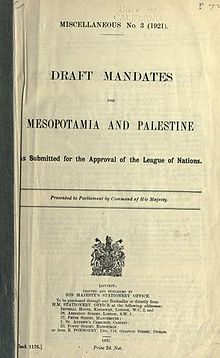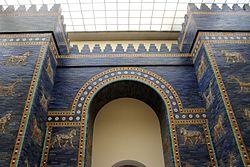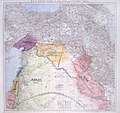Mandate for Mesopotamia
| Draft Mandate for Mesopotamia | |
|---|---|
 Draft mandates for Mesopotamia and Palestine as submitted for the approval of the League of Nations on December 7, 1920 | |
| Created | 1920 (draft only) |
| Ratified | Not ratified |
| Author(s) | League of Nations |
| Purpose | Proposed creation of the territory of Mesopotamia. The Kingdom of Iraq was created instead |
| History of Iraq |
|---|
 |
|
|
The Mandate for Mesopotamia (Arabic: الانتداب البريطاني على العراق) was a proposed League of Nations mandate to cover Ottoman Iraq (Mesopotamia). It would have been entrusted to the United Kingdom but was superseded by the Anglo-Iraqi Treaty, an agreement between Britain and Iraq with some similarities to the proposed mandate. On paper, it lasted for only 12 years from 1920-1932.
The proposed mandate was awarded on 25 April 1920, at the San Remo Conference in Italy in accordance with the 1916 Sykes–Picot Agreement, but was not yet documented or defined.[1] It was to be a class A mandate under Article 22 of the Covenant of the League of Nations. A draft mandate document was prepared by the British Colonial Office in June 1920, and submitted in draft form to the League of Nations in December 1920.
Immediately after the end of World War I, Sir Arnold Wilson, the future High Commissioner to Iraq, recommended the annexation of Mesopotamia to India "as a colony of India and the Indians, such as the government of India administer it and gradually cultivate its vast plains, and settle the warrior Punjab races in it."[2] In a memorandum written on 22 April 1918, Cox listed the social groups that the British should support: the Jewish community in Baghdad, the notables in Baghdad and Basara, the rich landowning Arabs and Jews, and the Shaikhs of sedentary tribes.[3] Mosul was added to the region of British influence following the 1918 Clemenceau–Lloyd George Agreement.
The proposed mandate faced certain difficulties to be established, as a nationwide Iraqi revolt broke out in 1920, after which it was decided the territory would become the Kingdom of Iraq, via the Anglo-Iraq Treaty of October 1922.[1] The Kingdom of Iraq became independent in 1931–1932,[1] in accordance with the League of Nations stance, which stated such states would be facilitated into "progressive development" as fully-independent states.[1]
The civil government of British-administered Iraq was headed originally by the High Commissioner, Sir Percy Cox, and his deputy, Colonel Arnold Wilson. British reprisals after the murder of a British officer in Najaf failed to restore order. British administration had yet to be established in the mountains of north Iraq. The most striking problem facing the British was the growing anger of the nationalists, who felt betrayed at being accorded mandate status.[citation needed]
Maps[]

Map presented by T.E. Lawrence to the Eastern Committee of the War Cabinet in November 1918[4]

British Map appended to 1921 CAB24/120 cabinet memorandum showing proposed mandates
Further reading[]
- Dodge, Toby "Inventing Iraq" (2009)
- Fieldhouse, David K. Western Imperialism in the Middle East, 1914–1958 (2006)
- Fisk, Robert. The Great War for Civilisation: The Conquest of the Middle East, (2nd ed. 2006),
- Simons, Geoff. Iraq: From Sumer to Saddam (2nd ed. 1994)
- Sluglett, Peter. Britain in Iraq: Contriving King and Country, 1914–1932 (2nd ed. 2007)
References[]
- ^ Jump up to: a b c d The new Cambridge modern history. Volume xii. p.293.
- ^ Nadhmi, Wamidh Jamal Umar (1984). Al-Judhour al-Siyasiyya wal Fikriyya wal Ijtima'yya Lilharaka al-Qawmiyya al-'Arabiyya (al-Istiqlaliyya) fil 'Iraq [The Political, Intellectual and Social Roots of the Arab Nationalist (Independent) Movement in Iraq] (in Arabic). Markaz Dirasat al-Wihda al-'Arabiyya, Beirut. p. 399.
- ^ Nadhmi 1984, p. 275.
- ^ Lawrence's Mid-East map on show
![]() This article incorporates public domain material from the Library of Congress Country Studies website http://lcweb2.loc.gov/frd/cs/.
This article incorporates public domain material from the Library of Congress Country Studies website http://lcweb2.loc.gov/frd/cs/.
- 20th century in Iraq
- Iraq–United Kingdom relations
- British colonisation of Asia
- League of Nations mandates
- Mandatory Iraq
- 1920 documents



